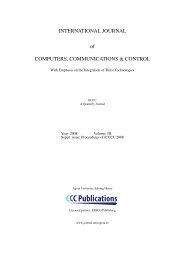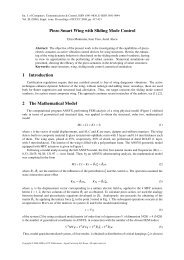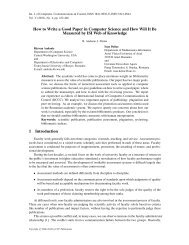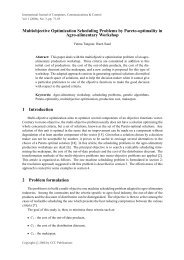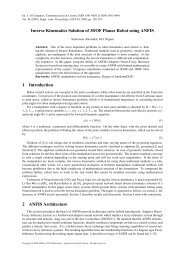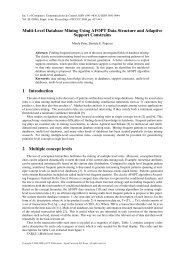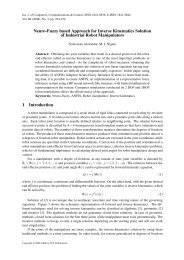Mining Association Rules from Empirical Data in the Domain of ...
Mining Association Rules from Empirical Data in the Domain of ...
Mining Association Rules from Empirical Data in the Domain of ...
You also want an ePaper? Increase the reach of your titles
YUMPU automatically turns print PDFs into web optimized ePapers that Google loves.
INT J COMPUT COMMUN, ISSN 1841-9836<br />
7(5):933-944, December, 2012.<br />
<strong>M<strong>in</strong><strong>in</strong>g</strong> <strong>Association</strong> <strong>Rules</strong> <strong>from</strong> <strong>Empirical</strong> <strong>Data</strong> <strong>in</strong> <strong>the</strong> Doma<strong>in</strong> <strong>of</strong><br />
Education<br />
Dragica Radosav, Eleonora Brtka,<br />
Vladimir Brtka<br />
University <strong>of</strong> Novi Sad<br />
Technical Faculty "Mihajlo Pup<strong>in</strong>"<br />
Serbia, 23000 Zrenjan<strong>in</strong>, Djure Djakovica bb<br />
E-mail: radosav@tfzr.uns.ac.rs,<br />
brtka@sbb.rs, vbrtka@tfzr.uns.ac.rs<br />
D. Radosav, E. Brtka, V. Brtka<br />
Abstract:<br />
The data m<strong>in</strong><strong>in</strong>g techniques and <strong>the</strong>ir applications are widely recognized as powerful<br />
tools <strong>in</strong> various doma<strong>in</strong>s. In <strong>the</strong> doma<strong>in</strong> <strong>of</strong> education <strong>the</strong>re is a variety <strong>of</strong> data <strong>of</strong><br />
various types that are collected. The important question is: Is it possible to process<br />
collected data with <strong>the</strong> data m<strong>in</strong><strong>in</strong>g technique and what are ma<strong>in</strong> advantages <strong>of</strong> data<br />
m<strong>in</strong><strong>in</strong>g and e-learn<strong>in</strong>g <strong>in</strong>teraction? If an e-learn<strong>in</strong>g system accumulates a huge volume<br />
<strong>of</strong> data, <strong>the</strong>n it is possible to deploy techniques and tools <strong>from</strong> <strong>the</strong> doma<strong>in</strong> <strong>of</strong> data<br />
m<strong>in</strong><strong>in</strong>g <strong>in</strong> order to ga<strong>in</strong> valuable <strong>in</strong>formation. The research presented <strong>in</strong> this paper<br />
is conducted on real-life data that orig<strong>in</strong>ates <strong>from</strong> <strong>the</strong> Balkan region. The s<strong>of</strong>tware<br />
system Weka is used to generate association rules. The ma<strong>in</strong> result <strong>of</strong> this research is<br />
<strong>the</strong> assessment <strong>of</strong> <strong>the</strong> parameters that are associated with <strong>the</strong> op<strong>in</strong>ion that computer<br />
skills will be helpful <strong>in</strong> <strong>the</strong> future, <strong>from</strong> <strong>the</strong> students po<strong>in</strong>t <strong>of</strong> view. This result is<br />
very important because it gives <strong>the</strong> exact <strong>in</strong>sight to computer technology usage <strong>in</strong><br />
<strong>the</strong> Balkans schools. Fur<strong>the</strong>rmore, some advantages <strong>of</strong> <strong>the</strong> usage <strong>of</strong> data m<strong>in</strong><strong>in</strong>g<br />
techniques <strong>in</strong> <strong>the</strong> doma<strong>in</strong> <strong>of</strong> education are determ<strong>in</strong>ed.<br />
Keywords: association rules, education, data m<strong>in</strong><strong>in</strong>g.<br />
1 Introduction<br />
In <strong>the</strong> past few years e-learn<strong>in</strong>g techniques have significantly improved as <strong>the</strong> result <strong>of</strong> progress<br />
and <strong>in</strong>creased use <strong>of</strong> <strong>the</strong> Internet. The "desktop" e-learn<strong>in</strong>g systems, <strong>in</strong> many cases, have been<br />
replaced by systems that operate us<strong>in</strong>g <strong>the</strong> Internet. Some <strong>of</strong> <strong>the</strong> web-based systems allow <strong>the</strong><br />
determ<strong>in</strong>ation <strong>of</strong> preferences for each participant <strong>in</strong> <strong>the</strong> process and adjustment <strong>of</strong> activities <strong>in</strong><br />
accordance with <strong>the</strong> pr<strong>of</strong>ile <strong>of</strong> participants [1]. Recently, techniques <strong>from</strong> <strong>the</strong> doma<strong>in</strong> <strong>of</strong> data m<strong>in</strong><strong>in</strong>g<br />
have been <strong>in</strong>corporated <strong>in</strong>to systems for e-learn<strong>in</strong>g. The changes that are constantly tak<strong>in</strong>g<br />
place <strong>in</strong> terms <strong>of</strong> rapid technical and technological developments affect society as a whole. The<br />
educational system is experienc<strong>in</strong>g changes <strong>in</strong> terms <strong>of</strong> modernization and globalization. However,<br />
<strong>the</strong> educational system that is "<strong>in</strong>ert" is not suitable for rapid change and modernization.<br />
The educational processes <strong>in</strong> Serbia and some o<strong>the</strong>r countries <strong>in</strong> <strong>the</strong> region <strong>of</strong> western Balkans<br />
are chang<strong>in</strong>g so that <strong>the</strong> "reproduction" style <strong>of</strong> learn<strong>in</strong>g is replaced with <strong>the</strong> style that prefers<br />
"understand<strong>in</strong>g" <strong>of</strong> <strong>the</strong> learn<strong>in</strong>g content and usage <strong>of</strong> <strong>the</strong> acquired knowledge. The <strong>the</strong>ories <strong>of</strong><br />
learn<strong>in</strong>g that are used are no longer associative and behavioral, but have become constructive<br />
and cognitive. Students are required to improve <strong>the</strong> style <strong>of</strong> self-tra<strong>in</strong><strong>in</strong>g and <strong>the</strong>ir skills. In <strong>the</strong>se<br />
processes <strong>the</strong> <strong>in</strong>formation capacity is an important factor <strong>in</strong> development, especially <strong>the</strong> Internet<br />
and <strong>the</strong> resources that are available through World Wide Web. The usage <strong>of</strong> <strong>the</strong> Internet by<br />
some Course Management System (CMS) is not unusual occurrence <strong>in</strong> Serbia, but cannot be<br />
said that such systems are widely present.<br />
Efforts that have been <strong>in</strong>vested <strong>in</strong> <strong>the</strong> <strong>in</strong>tegration <strong>of</strong> CMS and <strong>Data</strong> <strong>M<strong>in</strong><strong>in</strong>g</strong> (DM) systems<br />
are evident. This <strong>in</strong>tegration <strong>of</strong>ten means add<strong>in</strong>g DM modules to <strong>the</strong> exist<strong>in</strong>g CMS [1,2], but<br />
Copyright c○ 2006-2012 by CCC Publications
934 D. Radosav, E. Brtka, V. Brtka<br />
it is possible to approach to CMS and DM system <strong>in</strong>tegration through serial connection [3,4].<br />
Serial connection, <strong>in</strong> this case, means collect<strong>in</strong>g data with CMS, and <strong>the</strong>n process<strong>in</strong>g collected<br />
data by DM system. The results <strong>of</strong> DM analysis are fed back to CMS <strong>in</strong> order to improve <strong>the</strong>ir<br />
effectiveness.<br />
However, this paper lists <strong>the</strong> basic DM techniques and some tools that allow <strong>the</strong> application<br />
<strong>of</strong> <strong>the</strong>se techniques <strong>in</strong> doma<strong>in</strong> <strong>of</strong> education, but CMS and <strong>the</strong>ir application is not <strong>the</strong> topic <strong>of</strong><br />
this paper, although <strong>the</strong> importance <strong>of</strong> CMS is evident. This paper deals with some special<br />
DM techniques when applied to data collected <strong>in</strong> <strong>the</strong> doma<strong>in</strong> <strong>of</strong> education. The application <strong>of</strong><br />
DM techniques results <strong>in</strong> some rules or patterns that can be used as feedback to CMS. Ra<strong>the</strong>r<br />
than <strong>in</strong>vestigation <strong>of</strong> <strong>the</strong> connection between CMS and DM system, this paper deals with DM<br />
techniques when applied to data <strong>in</strong> <strong>the</strong> doma<strong>in</strong> <strong>of</strong> education and gives some conclusions and<br />
remarks about <strong>the</strong> importance <strong>of</strong> <strong>in</strong>ferred knowledge. Special contribution is <strong>the</strong> analysis <strong>of</strong> <strong>the</strong><br />
results <strong>of</strong> DM technique when applied to real-life data collected <strong>from</strong> <strong>the</strong> region <strong>of</strong> Serbia and<br />
Bosnia and Herzegov<strong>in</strong>a.<br />
The paper is organized as follows: section two gives <strong>the</strong> short description <strong>of</strong> various DM<br />
techniques used <strong>in</strong> <strong>the</strong> doma<strong>in</strong> <strong>of</strong> education. One <strong>of</strong> DM techniques is chosen to be used for<br />
<strong>the</strong> analysis <strong>of</strong> <strong>the</strong> real-life data. It is expla<strong>in</strong>ed why this DM technique is <strong>the</strong> most suitable<br />
<strong>in</strong> this particular case. Section three conta<strong>in</strong>s data description, as well as <strong>the</strong> methodology<br />
description. Section four lists <strong>the</strong> results obta<strong>in</strong>ed by application <strong>of</strong> <strong>the</strong> DM technique, as well as<br />
<strong>the</strong> <strong>in</strong>terpretation <strong>of</strong> <strong>the</strong>se results. F<strong>in</strong>ally, section five conta<strong>in</strong>s conclusions and remarks about<br />
applicability <strong>of</strong> DM techniques <strong>in</strong> <strong>the</strong> doma<strong>in</strong> <strong>of</strong> education.<br />
2 Previous Work and DM Techniques<br />
The well-known CMS that are <strong>in</strong> use are: Blackboard, WebCT, ANGEL and Moodle. In<br />
previous papers DM techniques are used as a functional element (module) <strong>of</strong> CMS [2,5]. The<br />
DM module can be an <strong>in</strong>tegral part <strong>of</strong> CMS but, <strong>in</strong> some cases, can be used separately. The<br />
field <strong>of</strong> data m<strong>in</strong><strong>in</strong>g, like statistics, concerns itself with "learn<strong>in</strong>g <strong>from</strong> data" or "turn<strong>in</strong>g data<br />
<strong>in</strong>to <strong>in</strong>formation" [6]. Accord<strong>in</strong>g to [5,7], DM can be def<strong>in</strong>ed as <strong>the</strong> <strong>in</strong>tersection <strong>of</strong> <strong>the</strong> doma<strong>in</strong> <strong>of</strong><br />
statistics, computer science, artificial <strong>in</strong>telligence, mach<strong>in</strong>e learn<strong>in</strong>g, database management and<br />
data visualization. <strong>Data</strong> m<strong>in</strong><strong>in</strong>g is <strong>the</strong> process <strong>of</strong> identify<strong>in</strong>g valid, novel, potentially useful, and<br />
ultimately comprehensible and understandable patterns or models.<br />
The basic techniques <strong>of</strong> data m<strong>in</strong><strong>in</strong>g are [7]:<br />
• Classification - exam<strong>in</strong><strong>in</strong>g <strong>the</strong> feature <strong>of</strong> a newly presented object and assign<strong>in</strong>g it to a<br />
predef<strong>in</strong>ed set <strong>of</strong> classes.<br />
• Aff<strong>in</strong>ity group<strong>in</strong>g or association rules - determ<strong>in</strong><strong>in</strong>g which th<strong>in</strong>gs go toge<strong>the</strong>r, also known<br />
as dependency model<strong>in</strong>g.<br />
• Cluster<strong>in</strong>g - segment<strong>in</strong>g a population <strong>in</strong>to a number <strong>of</strong> subgroups or clusters. Description<br />
and visualization - exploratory or visual data m<strong>in</strong><strong>in</strong>g.<br />
2.1 The Application <strong>of</strong> <strong>the</strong> DM<br />
In practice, <strong>the</strong>re are a lot <strong>of</strong> general and specific data m<strong>in</strong><strong>in</strong>g tools [2]. The commercial<br />
m<strong>in</strong><strong>in</strong>g tools are: DBM<strong>in</strong>er [8], SPSS Clement<strong>in</strong>e: [9] and DB2 Intelligent M<strong>in</strong>er [10], etc. Some<br />
public doma<strong>in</strong> m<strong>in</strong><strong>in</strong>g tools are: Weka [11] and Keel [12]. There are also specific educational<br />
data m<strong>in</strong><strong>in</strong>g tools such as: <strong>M<strong>in</strong><strong>in</strong>g</strong> tool [13] for association and pattern m<strong>in</strong><strong>in</strong>g, MultiStar [14]
<strong>M<strong>in</strong><strong>in</strong>g</strong> <strong>Association</strong> <strong>Rules</strong> <strong>from</strong> <strong>Empirical</strong> <strong>Data</strong> <strong>in</strong> <strong>the</strong> Doma<strong>in</strong> <strong>of</strong> Education 935<br />
for association and classification, KAON [15] for cluster<strong>in</strong>g and text m<strong>in</strong><strong>in</strong>g and CIECoF [16] for<br />
association rule m<strong>in</strong><strong>in</strong>g. The application <strong>of</strong> <strong>the</strong>se systems <strong>in</strong> <strong>the</strong> field <strong>of</strong> education <strong>in</strong>cludes <strong>the</strong><br />
selection <strong>of</strong> suitable DM techniques. It is not unusual that multiple DM techniques are applied<br />
to <strong>the</strong> same data sample.<br />
As <strong>in</strong> [2,7] <strong>the</strong> ma<strong>in</strong> steps <strong>of</strong> application <strong>of</strong> DM techniques are:<br />
1. Collection <strong>of</strong> <strong>the</strong> data. The CMS system is used and <strong>the</strong> collected data are stored <strong>in</strong><br />
database. This step can be executed by a questionnaire or some o<strong>the</strong>r data collection<br />
technique <strong>in</strong>stead <strong>of</strong> CMS usage.<br />
2. Preprocess<strong>in</strong>g <strong>the</strong> data. The data is "cleaned" and transformed <strong>in</strong>to an appropriate format<br />
to be m<strong>in</strong>ed.<br />
3. Application <strong>of</strong> suitable DM technique. The DM technique is applied to build <strong>the</strong> model<br />
that discovers new rules, patterns and knowledge. To execute this step, ei<strong>the</strong>r a general or<br />
a specific data m<strong>in</strong><strong>in</strong>g tool, or a commercial or a free data m<strong>in</strong><strong>in</strong>g tool can be used.<br />
4. The <strong>in</strong>terpretation, evaluation and deployment <strong>of</strong> <strong>the</strong> results.<br />
In particular, it is necessary to apply and elaborate <strong>in</strong> detail each <strong>of</strong> <strong>the</strong>se steps depend<strong>in</strong>g<br />
on <strong>the</strong> data to be analyzed. Some <strong>of</strong> <strong>the</strong> systems for data m<strong>in</strong><strong>in</strong>g that are used to analyze data<br />
<strong>from</strong> different doma<strong>in</strong>s are:<br />
• Rosetta system, developed by researchers <strong>from</strong> <strong>the</strong> University <strong>of</strong> Warsaw and <strong>the</strong> University<br />
<strong>of</strong> Trondheim [17,18]. Rosetta is capable <strong>of</strong> syn<strong>the</strong>sis <strong>of</strong> <strong>the</strong> IF ... THEN rules by<br />
usage <strong>of</strong> <strong>the</strong> Rough sets <strong>the</strong>ory. This system is based on classification, reduction <strong>of</strong> data<br />
and decision rules syn<strong>the</strong>sis.<br />
• Weka system was developed by researchers <strong>from</strong> <strong>the</strong> University <strong>of</strong> Waikato, New Zealand<br />
[19].<br />
Rosetta system allows data to be loaded <strong>from</strong> MS Excel table; <strong>the</strong> format <strong>of</strong> <strong>the</strong> loaded data<br />
can also be CSV (Comma Separated Values). Rosetta system performs <strong>the</strong> extraction <strong>of</strong> <strong>the</strong><br />
IF...THEN rules. The data can be collected by various methods; <strong>the</strong> format <strong>of</strong> <strong>the</strong> collected data<br />
does not have to be specially adapted to DM techniques implemented <strong>in</strong> Rosetta.<br />
On <strong>the</strong> o<strong>the</strong>r hand, <strong>the</strong> Weka GUI Chooser provides a start<strong>in</strong>g po<strong>in</strong>t for launch<strong>in</strong>g Wekas ma<strong>in</strong><br />
GUI applications and support<strong>in</strong>g tools. The Weka system can be used to start <strong>the</strong> particular<br />
DM applications:<br />
• Explorer - An environment for explor<strong>in</strong>g data with Weka.<br />
• Experimenter - An environment for perform<strong>in</strong>g experiments and conduct<strong>in</strong>g statistical tests<br />
between learn<strong>in</strong>g schemes.<br />
• KnowledgeFlow - This application supports essentially <strong>the</strong> same functions as <strong>the</strong> Explorer<br />
but with a drag-and-drop <strong>in</strong>terface. One advantage is that it supports <strong>in</strong>cremental learn<strong>in</strong>g.<br />
• SimpleCLI - Provides a simple command-l<strong>in</strong>e <strong>in</strong>terface that allows direct execution <strong>of</strong> Weka<br />
commands for operat<strong>in</strong>g systems that do not provide <strong>the</strong>ir own command l<strong>in</strong>e <strong>in</strong>terface.<br />
System Weka allows (see Figure 1):
936 D. Radosav, E. Brtka, V. Brtka<br />
Figure 1: The ma<strong>in</strong> menu <strong>of</strong> Weka system<br />
• Classification (Classify) - A classifier is a mapp<strong>in</strong>g <strong>from</strong> a (discrete or cont<strong>in</strong>uous) feature<br />
space X to a discrete set <strong>of</strong> labels Y [20]. Classification or discrim<strong>in</strong>ant analysis predicts<br />
class labels. This is supervised classification which provides a collection <strong>of</strong> labeled preclassified<br />
patterns; <strong>the</strong> problem be<strong>in</strong>g to label a newly encountered, still unlabeled, pattern.<br />
In e-learn<strong>in</strong>g, classification has been used for: discover<strong>in</strong>g potential student groups with<br />
similar characteristics and reactions to a specific pedagogical strategy [21]; predict<strong>in</strong>g students<br />
performance and <strong>the</strong>ir f<strong>in</strong>al grade [22]; detect<strong>in</strong>g students misuse or students play<strong>in</strong>g<br />
around [23]; predict<strong>in</strong>g <strong>the</strong> students performance, as well as assess<strong>in</strong>g <strong>the</strong> relevance <strong>of</strong> <strong>the</strong><br />
attributes <strong>in</strong>volved [24]; group<strong>in</strong>g students as h<strong>in</strong>t-driven or failure-driven and f<strong>in</strong>d<strong>in</strong>g students<br />
common misconceptions [25]; identify<strong>in</strong>g learners with little motivation and f<strong>in</strong>d<strong>in</strong>g<br />
remedial actions <strong>in</strong> order to lower drop-out rates [26]; for predict<strong>in</strong>g course success [27].<br />
• Cluster<strong>in</strong>g (Cluster) - Cluster<strong>in</strong>g is a process <strong>of</strong> group<strong>in</strong>g objects <strong>in</strong>to classes <strong>of</strong> similar<br />
objects [28]. It is an unsupervised classification or partition<strong>in</strong>g <strong>of</strong> patterns <strong>in</strong>to groups or<br />
subsets (clusters) based on <strong>the</strong>ir locality and connectivity with<strong>in</strong> an n-dimensional space.<br />
In e-learn<strong>in</strong>g, cluster<strong>in</strong>g has been used for: f<strong>in</strong>d<strong>in</strong>g clusters <strong>of</strong> students with similar learn<strong>in</strong>g<br />
characteristics, and for promot<strong>in</strong>g group-based collaborative learn<strong>in</strong>g, as well as for provid<strong>in</strong>g<br />
<strong>in</strong>cremental learner diagnosis [29]; group<strong>in</strong>g students and personalized it<strong>in</strong>eraries<br />
for courses based on learn<strong>in</strong>g objects [30]; group<strong>in</strong>g students <strong>in</strong> order to give <strong>the</strong>m differentiated<br />
guid<strong>in</strong>g accord<strong>in</strong>g to <strong>the</strong>ir skills and o<strong>the</strong>r characteristics [31]; group<strong>in</strong>g tests and<br />
questions <strong>in</strong>to related groups based on <strong>the</strong> data <strong>in</strong> <strong>the</strong> score matrix [32].<br />
• <strong>Association</strong> rule m<strong>in</strong><strong>in</strong>g (Associate) - <strong>Association</strong> rule m<strong>in</strong><strong>in</strong>g discovers relationships<br />
among attributes <strong>in</strong> databases, produc<strong>in</strong>g if-<strong>the</strong>n statements concern<strong>in</strong>g attribute-values<br />
[33]. An association rule expresses a close correlation between items (attribute-value)<br />
<strong>in</strong> a database with values <strong>of</strong> support and confidence. The confidence <strong>of</strong> <strong>the</strong> rule is <strong>the</strong><br />
percentage <strong>of</strong> transactions that conta<strong>in</strong>s <strong>the</strong> consequence <strong>in</strong> transactions that conta<strong>in</strong> <strong>the</strong>
<strong>M<strong>in</strong><strong>in</strong>g</strong> <strong>Association</strong> <strong>Rules</strong> <strong>from</strong> <strong>Empirical</strong> <strong>Data</strong> <strong>in</strong> <strong>the</strong> Doma<strong>in</strong> <strong>of</strong> Education 937<br />
antecedent. The support <strong>of</strong> <strong>the</strong> rule is <strong>the</strong> percentage <strong>of</strong> transactions that conta<strong>in</strong>s both<br />
antecedent and consequence <strong>in</strong> all transactions <strong>in</strong> <strong>the</strong> database. <strong>Association</strong> rule m<strong>in</strong><strong>in</strong>g<br />
has been applied to web-based educational systems for: build<strong>in</strong>g recommender agents that<br />
could recommend on-l<strong>in</strong>e learn<strong>in</strong>g activities or shortcuts [34]; diagnos<strong>in</strong>g student learn<strong>in</strong>g<br />
problems and <strong>of</strong>fer<strong>in</strong>g students advice [35]; guid<strong>in</strong>g <strong>the</strong> learners activities automatically<br />
and recommend<strong>in</strong>g learn<strong>in</strong>g materials [36]; determ<strong>in</strong><strong>in</strong>g which learn<strong>in</strong>g materials are <strong>the</strong><br />
most suitable to be recommended to <strong>the</strong> user [37]; identify<strong>in</strong>g attributes characteriz<strong>in</strong>g<br />
patterns <strong>of</strong> performance disparity between various groups <strong>of</strong> students [38]; discover<strong>in</strong>g<br />
<strong>in</strong>terest<strong>in</strong>g relationships <strong>from</strong> students usage <strong>in</strong>formation <strong>in</strong> order to provide feedback to<br />
<strong>the</strong> author <strong>of</strong> <strong>the</strong> course [39]; f<strong>in</strong>d<strong>in</strong>g out relationships <strong>in</strong> learners behavior patterns [40];<br />
f<strong>in</strong>d<strong>in</strong>g students mistakes that <strong>of</strong>ten accompany each o<strong>the</strong>r [41]; guid<strong>in</strong>g <strong>the</strong> search for<br />
<strong>the</strong> best fitt<strong>in</strong>g transfer models <strong>of</strong> student learn<strong>in</strong>g [42]; and optimiz<strong>in</strong>g <strong>the</strong> content <strong>of</strong> <strong>the</strong><br />
e-learn<strong>in</strong>g portal by determ<strong>in</strong><strong>in</strong>g what most <strong>in</strong>terests <strong>the</strong> user [43].<br />
• Select<strong>in</strong>g Attributes (Select attributes) - Attribute selection <strong>in</strong>volves search<strong>in</strong>g through<br />
all possible comb<strong>in</strong>ations <strong>of</strong> attributes <strong>in</strong> <strong>the</strong> data to f<strong>in</strong>d which subset <strong>of</strong> attributes works<br />
best for prediction. To do this, two objects must be set up: an attribute evaluator and a<br />
search method. The evaluator determ<strong>in</strong>es what method is used to assign a value to each<br />
subset <strong>of</strong> attributes. The search method determ<strong>in</strong>es what style <strong>of</strong> search is performed.<br />
• Visualization (Visualize) - Information visualization [44] is a branch <strong>of</strong> computer graphics<br />
and user <strong>in</strong>terface which is concerned with <strong>the</strong> presentation <strong>of</strong> <strong>in</strong>teractive or animated<br />
digital images so that users can understand data. These techniques facilitate analysis<br />
<strong>of</strong> large amounts <strong>of</strong> <strong>in</strong>formation by represent<strong>in</strong>g <strong>the</strong> data <strong>in</strong> some visual display. Weka<br />
visualization section allows visualiz<strong>in</strong>g 2D plots <strong>of</strong> <strong>the</strong> current relation.<br />
Rosetta system and Weka are particularly suitable for data analysis <strong>in</strong> <strong>the</strong> field <strong>of</strong> education<br />
because <strong>the</strong>y <strong>of</strong>fer a selection <strong>of</strong> DM techniques and are relatively easy to use.<br />
3 Methodology<br />
The data sample, <strong>in</strong> form <strong>of</strong> MS Excel document, consists <strong>of</strong> a total <strong>of</strong> 256 <strong>in</strong>stances (students).<br />
It is important to mention that <strong>the</strong> data are not collected with <strong>the</strong> aim to be analyzed<br />
by DM techniques. The survey was conducted on students <strong>from</strong> <strong>the</strong> territory <strong>of</strong> <strong>the</strong> Republic <strong>of</strong><br />
Serbia and <strong>the</strong> territory <strong>of</strong> Bosnia and Herzegov<strong>in</strong>a. The computer technology that is used <strong>in</strong> this<br />
region is mostly out <strong>of</strong> date but is sufficient for elementary usage <strong>in</strong> education. Description <strong>of</strong> <strong>the</strong><br />
data, presented <strong>in</strong> Table 1, shows <strong>the</strong> names <strong>of</strong> attributes and <strong>the</strong>ir possible values. Attribute<br />
names and associated values comply with <strong>the</strong> form <strong>of</strong> survey.<br />
Various techniques can be used on this small data set: First <strong>of</strong> all, <strong>the</strong>re are statistical<br />
techniques, for example students distribution that is used when estimat<strong>in</strong>g <strong>the</strong> mean <strong>of</strong> a normally<br />
distributed population when <strong>the</strong> data set is small; <strong>the</strong>n <strong>the</strong>re are techniques for <strong>in</strong>ferr<strong>in</strong>g decision<br />
rules (based on Pawlaks rough sets <strong>the</strong>ory, decision trees, etc.), even neural networks can be<br />
tra<strong>in</strong>ed on small data set [45]. In addition, <strong>the</strong> data sample which is described <strong>in</strong> Table 1 can be<br />
analyzed by various DM techniques or DM systems. The association rule m<strong>in</strong><strong>in</strong>g is adopted as<br />
<strong>the</strong> most suitable DM technique.<br />
As def<strong>in</strong>ed by Agrawal et al. [33] <strong>the</strong> problem <strong>of</strong> association rule m<strong>in</strong><strong>in</strong>g is def<strong>in</strong>ed as:<br />
Let U = {u1,u2,...,um} be a discrete universe, a f<strong>in</strong>ite set <strong>of</strong> objects. Let A = {a1,a2,...,an}<br />
be a f<strong>in</strong>ite set <strong>of</strong> attributes with b<strong>in</strong>ary values. Each object <strong>of</strong> universe U is described by<br />
attributes ai, i = 1,2,...,n thus generat<strong>in</strong>g a data set. An associative rule is def<strong>in</strong>ed as an<br />
implication <strong>of</strong> <strong>the</strong> form X ⇒ Y where X,Y ∈ A and X ∩ Y = ⊘. The set <strong>of</strong> attributes X is
938 D. Radosav, E. Brtka, V. Brtka<br />
Table 1: Description <strong>of</strong> used data, attribute names and <strong>the</strong>ir possible values<br />
Name Value, number <strong>of</strong> objects and distribution Description <strong>of</strong> <strong>the</strong> attribute<br />
A1 1. yes, 210 , 82.03125% Does <strong>the</strong> student<br />
2. no, 46, 17.96875% has a computer at home<br />
A2 1. do not know, 31, 12.109375% What type <strong>of</strong> computer<br />
2. o<strong>the</strong>r, 7, 2.734375% do <strong>the</strong> student have<br />
3. PII, 7, 2.734376%<br />
4. PIII, 60, 23.4375%<br />
5. PIV, 144, 56.25%<br />
6. laptop, 7, 2.734376%<br />
A3 1. yes, 123, 48.046875% Does <strong>the</strong> student<br />
2. no, 133, 51.953125% use <strong>the</strong> Internet<br />
A4 1. 1 hour per day, 98, 38.28125% How many hours per day<br />
2. 2 hours per day, 85, 33.203125% does <strong>the</strong> student use<br />
3. 3 hours a day, 23, 8.984375% <strong>the</strong> computer<br />
4. 4 hours a day, 24, 9.375%<br />
5. 5 hours a day, 26, 10.15625%<br />
A5 1. 0 hours a day, 67, 26.171875% How many hours<br />
2. 1 hour per day, 74, 28.90625% per day<br />
3. 2 hours per day, 64, 25.0% <strong>the</strong> student<br />
4. 3 hours a day, 18, 7.03125% use <strong>the</strong> Internet<br />
5. 4 hours a day, 12, 4.6875%<br />
6. 5 hours a day, 21, 8.203125%<br />
A6 1. yes, 89, 34.765625% Does <strong>the</strong> student use<br />
2. no, 167, 65.234375% e-mail<br />
A7 1. web sites on Serbian, 142, 55.46875% What web sites does<br />
2. web sites on o<strong>the</strong>r lenguages, 114, 44.53125% <strong>the</strong> student visit<br />
most frequently<br />
A8 1. educational, 27, 10.546875% What k<strong>in</strong>d <strong>of</strong> web sites<br />
2. enterta<strong>in</strong>ment, 116, 45.3125% is <strong>the</strong> most visited<br />
3. o<strong>the</strong>r, 113, 44.140625% by student<br />
A9 1. yes, 185, 72.265625% Does <strong>the</strong> student use<br />
2. no, 71, 27.734375% his/her home computer<br />
for learn<strong>in</strong>g<br />
A10 1. educational, 42, 16.40625% What type <strong>of</strong> media does<br />
2. film, 18, 7.03125% <strong>the</strong> student use most<br />
3. music, 130, 50.78125% frequently at home<br />
4. o<strong>the</strong>r, 66, 25.78225%<br />
A11 1. yes, 159, 62.109375% Does <strong>the</strong> student want<br />
2. no, 5, 1.953125% more educational<br />
3. do not know, 92, 35.9375% computer s<strong>of</strong>tware to be<br />
used <strong>in</strong> school <strong>in</strong> order to<br />
improve teach<strong>in</strong>g<br />
A12 1. yes, 192, 75.0% Does <strong>the</strong> student want to<br />
2. no, 30, 11.71875% review learn<strong>in</strong>g materials<br />
3. do not know, 34, 13.28125% used <strong>in</strong> school, by Distant<br />
Learn<strong>in</strong>g System at home<br />
A13 1. games, 78, 30.46875% What type <strong>of</strong> s<strong>of</strong>tware is<br />
2. educational, 11, 4.296875% most frequently used by<br />
3. games, educational, 167, 65.234375% student<br />
A14 1. yes, 221, 86.328125% Does <strong>the</strong> student like <strong>the</strong><br />
2. no, 35, 13.671875% subject <strong>of</strong> <strong>in</strong>formatics<br />
A15 1. yes, 219, 85.546875% Does <strong>the</strong> student believe<br />
2. no, 37, 14.453125% that he/she ga<strong>in</strong>ed enough<br />
knowledge to work<br />
<strong>in</strong>dependently on a<br />
computer<br />
A16 1. <strong>in</strong>dependently, 82, 32.03125% From who or where has<br />
2. <strong>from</strong> o<strong>the</strong>rs, 36, 14.0625% <strong>the</strong> student learned most<br />
3. at school, 138, 53.90625% about computer usage<br />
A17 1. yes, 235, 91.796875% Does <strong>the</strong> student th<strong>in</strong>k<br />
2. no, 21, 8.203125% that his/her computer skills<br />
will help him/her <strong>in</strong> <strong>the</strong><br />
future
<strong>M<strong>in</strong><strong>in</strong>g</strong> <strong>Association</strong> <strong>Rules</strong> <strong>from</strong> <strong>Empirical</strong> <strong>Data</strong> <strong>in</strong> <strong>the</strong> Doma<strong>in</strong> <strong>of</strong> Education 939<br />
Table 2: Simple example <strong>of</strong> data set<br />
Object The student has The student uses The student th<strong>in</strong>ks that<br />
a computer at home <strong>the</strong> Internet his/her computer skills<br />
will help him/her <strong>in</strong> <strong>the</strong> future<br />
(A1) (A2) (A3)<br />
1. yes yes no<br />
2. no yes yes<br />
3. no no no<br />
4. yes yes yes<br />
5. no yes no<br />
called antecedent (left-hand-side or LHS) <strong>of</strong> <strong>the</strong> rule; <strong>the</strong> set <strong>of</strong> attributes Y is called consequent<br />
(right-hand-side or RHS) <strong>of</strong> <strong>the</strong> rule.<br />
There are many rules <strong>of</strong> <strong>the</strong> form X ⇒ Y , but to select <strong>in</strong>terest<strong>in</strong>g rules <strong>from</strong> <strong>the</strong> set <strong>of</strong><br />
all possible rules, various measures <strong>of</strong> significance can be used; <strong>the</strong> best-known are m<strong>in</strong>imum<br />
thresholds on support and confidence. The support supp(X) is def<strong>in</strong>ed as <strong>the</strong> proportion <strong>of</strong><br />
objects <strong>in</strong> <strong>the</strong> data set which conta<strong>in</strong>s <strong>the</strong> attributes <strong>from</strong> X. The confidence <strong>of</strong> a rule is def<strong>in</strong>ed<br />
as:<br />
conf(X ⇒ Y) =<br />
supp(X ∪Y)<br />
supp(X)<br />
The previous concepts are expla<strong>in</strong>ed <strong>in</strong> next simple example. For a data set given <strong>in</strong> Table 2<br />
it is possible to <strong>in</strong>fer some association rules, as well as <strong>the</strong> confidence and support parameters.<br />
For X = {A1,A2,A3} supp(X) = 1<br />
= 0.2 because <strong>the</strong>re is one object (number four) for<br />
5<br />
which <strong>the</strong>re is a "yes" value for every attribute.<br />
For example, <strong>the</strong> confidence <strong>of</strong> <strong>the</strong> rule X ⇒ Y , where X = {A1,A2} and Y = {A3} is:<br />
conf(X ⇒ Y) =<br />
supp(X ∪Y)<br />
supp(X)<br />
0.2<br />
= = 0.5<br />
0.4<br />
The previous rule X ⇒ Y is <strong>in</strong>terpreted as follows: The student who has a computer at<br />
home and uses <strong>the</strong> Internet is associated with <strong>the</strong> op<strong>in</strong>ion that his/her computer skills will help<br />
him/her <strong>in</strong> <strong>the</strong> future.<br />
There are many algorithms for association rule computation, but so called apriori algorithm<br />
[46] is <strong>the</strong> best-known algorithm to m<strong>in</strong>e association rules. It is based on breadth-first search<br />
strategy [47]. In <strong>the</strong> data set described by Table 2 attribute selection is more complicated by<br />
<strong>the</strong> fact that some attribute values are not b<strong>in</strong>ary so this <strong>in</strong>volves more extensive search.<br />
The association rule generation is chosen to be performed due to multiple reasons:<br />
1. This is an exact method and <strong>the</strong>refore excludes any subjective <strong>in</strong>fluence while analyz<strong>in</strong>g<br />
data set.<br />
2. The result is presented <strong>in</strong> a readable and easy-to-understand form.<br />
3. It is expected that number <strong>of</strong> generated association rules would not be high (data set<br />
conta<strong>in</strong>s 256 <strong>in</strong>stances) due to computation <strong>of</strong> confidence for each rule and selection <strong>of</strong><br />
rules with <strong>the</strong> highest confidence.<br />
4. It is expected that association rules have a great value when <strong>in</strong>ferred <strong>from</strong> data set <strong>in</strong><br />
education doma<strong>in</strong> because association rules can be treated as a hypo<strong>the</strong>sis.
940 D. Radosav, E. Brtka, V. Brtka<br />
The experiment was conducted on data set by s<strong>of</strong>tware system Weka <strong>in</strong> order to generate<br />
association rules. After load<strong>in</strong>g, <strong>the</strong> data are ready for pre-process<strong>in</strong>g and application <strong>of</strong> DM<br />
techniques. Weka system requires that <strong>the</strong> attributes with numerical values do not participate<br />
<strong>in</strong> <strong>the</strong> association rule m<strong>in</strong><strong>in</strong>g, so <strong>the</strong>y are ignored. <strong>Association</strong> rules generated by Weka system<br />
(apriori algorithm is used) are shown <strong>in</strong> Table 3.<br />
Table 3: <strong>Association</strong> rules generated by apriori algorithm<br />
Rule IF THEN Rule confidence<br />
1 A11=yes, 159 A17=yes, 154 0.97<br />
2 A9=yes AND A14=yes, 159 A17=yes, 154 0.97<br />
3 A13=games, educational, 167 A17=yes, 159 0.95<br />
4 A9=yes AND A15=yes, 166 A17=yes, 158 0.95<br />
5 A12=yes AND A14=yes, 169 A17=yes, 160 0.95<br />
6 A9=yes, 185 A17=yes, 174 0.94<br />
7 A14=yes AND A15=yes, 195 A17=yes, 183 0.94<br />
8 A12=yes, 192 A17=yes, 180 0.94<br />
9 A6=no, 167 A17=yes, 156 0.93<br />
10 A14=yes, 221 A17=yes, 206 0.93<br />
There are 10 rules generated. The IF part <strong>of</strong> every rule is followed by support measure, as is<br />
<strong>the</strong> case with <strong>the</strong> THEN part <strong>of</strong> each rule. The confidence for each rule is given <strong>in</strong> <strong>the</strong> separate<br />
column.<br />
4 Results<br />
The Analysis <strong>of</strong> generated association rules provides <strong>in</strong>sight <strong>in</strong>to <strong>the</strong> dependence <strong>of</strong> <strong>the</strong> monitored<br />
parameters. Each rule is accompanied by a factor <strong>of</strong> confidence that takes a value <strong>in</strong> <strong>the</strong><br />
range [0, 1]. Ten association rules have been generated, see Table 3.<br />
By association rule 1 attribute A11 (Does <strong>the</strong> student want more educational computer<br />
s<strong>of</strong>tware to be used <strong>in</strong> school <strong>in</strong> order to improve learn<strong>in</strong>g) is associated with attribute A17<br />
(Does <strong>the</strong> student th<strong>in</strong>k that his/her computer skills will help him/her <strong>in</strong> <strong>the</strong> future). The factor<br />
<strong>of</strong> confidence for this rule is 0.97, that rule is guaranteed to a great extent. If <strong>the</strong> value <strong>of</strong><br />
attribute A11 is "yes" <strong>the</strong>n, by this association rule, <strong>the</strong> value <strong>of</strong> attribute A17 is also "yes".<br />
A possible conclusion which can be drawn is that most <strong>of</strong> <strong>the</strong> students th<strong>in</strong>k that usage <strong>of</strong><br />
computer technology <strong>in</strong> school generates skills and knowledge that could be used <strong>in</strong> <strong>the</strong> future.<br />
This students op<strong>in</strong>ion is a good <strong>in</strong>dicator <strong>of</strong> <strong>the</strong> importance <strong>of</strong> <strong>the</strong> usage <strong>of</strong> computer technology<br />
and educational s<strong>of</strong>tware <strong>in</strong> teach<strong>in</strong>g process. It is evident that technology usage <strong>in</strong> future is<br />
closely related to computer technology s<strong>of</strong>tware and methods which are used at present. O<strong>the</strong>r<br />
association rules can be <strong>in</strong>terpreted <strong>in</strong> analogous way.<br />
The rule 2 can be <strong>in</strong>terpreted as follows. Two facts: The fact that student uses home computer<br />
for learn<strong>in</strong>g and <strong>the</strong> fact that student likes <strong>the</strong> subjects <strong>of</strong> computer science, are associated with<br />
op<strong>in</strong>ion that computer skills will be helpful <strong>in</strong> <strong>the</strong> future. Rule number 3 associates <strong>the</strong> type <strong>of</strong><br />
s<strong>of</strong>tware that is most frequently used by student (games, educational s<strong>of</strong>tware) with <strong>the</strong> op<strong>in</strong>ion<br />
that computer skills will be helpful <strong>in</strong> <strong>the</strong> future.<br />
The op<strong>in</strong>ion that computer skills will be helpful <strong>in</strong> <strong>the</strong> future is mostly associated with:<br />
believ<strong>in</strong>g that student ga<strong>in</strong>ed enough knowledge to work <strong>in</strong>dependently on a computer, <strong>the</strong> usage<br />
<strong>of</strong> <strong>the</strong> computer for learn<strong>in</strong>g and aspiration to use distant learn<strong>in</strong>g system at home to review<br />
learn<strong>in</strong>g materials previously used <strong>in</strong> school. Attribute A14 (The student likes <strong>the</strong> subject <strong>of</strong><br />
computer science) is most frequently associated with op<strong>in</strong>ion that computer skills will be helpful<br />
<strong>in</strong> <strong>the</strong> future.
<strong>M<strong>in</strong><strong>in</strong>g</strong> <strong>Association</strong> <strong>Rules</strong> <strong>from</strong> <strong>Empirical</strong> <strong>Data</strong> <strong>in</strong> <strong>the</strong> Doma<strong>in</strong> <strong>of</strong> Education 941<br />
However, rule number n<strong>in</strong>e associate <strong>the</strong> students that are not satisfied with <strong>the</strong> usage <strong>of</strong><br />
e-mail with <strong>the</strong> op<strong>in</strong>ion that computer skills will be helpful <strong>in</strong> <strong>the</strong> future. In fact, this may be<br />
<strong>in</strong> accordance with rule number eight: The usage <strong>of</strong> distant learn<strong>in</strong>g system at home to review<br />
learn<strong>in</strong>g materials previously used <strong>in</strong> school is associated with <strong>the</strong> op<strong>in</strong>ion that computer skills<br />
will be helpful <strong>in</strong> <strong>the</strong> future. So, <strong>in</strong> students op<strong>in</strong>ion, distant learn<strong>in</strong>g system makes e-mail service<br />
obsolete <strong>in</strong> a way.<br />
5 Conclusions and Future Works<br />
The application <strong>of</strong> association rule m<strong>in</strong><strong>in</strong>g allows automatic generation <strong>of</strong> hypo<strong>the</strong>ses and<br />
factors <strong>of</strong> confidence that are related to <strong>the</strong>m. Consider<strong>in</strong>g rule number one (see Table 3) <strong>the</strong><br />
hypo<strong>the</strong>sis is: If a student wants more educational computer s<strong>of</strong>tware to be used <strong>in</strong> school <strong>in</strong> order<br />
to improve learn<strong>in</strong>g <strong>the</strong>n <strong>the</strong> student th<strong>in</strong>ks that his/her computer skills will help him/her <strong>in</strong> <strong>the</strong><br />
future. O<strong>the</strong>r rules may also be <strong>in</strong>terpreted as a hypo<strong>the</strong>sis. Obviously <strong>the</strong> factor <strong>of</strong> confidence<br />
has a great impact on confirmation <strong>of</strong> hypo<strong>the</strong>ses. At <strong>the</strong> Technical Faculty "Mihajlo Pup<strong>in</strong>"<br />
<strong>in</strong> Zrenjan<strong>in</strong>, Serbia, extensive research is underway, <strong>in</strong>vestigat<strong>in</strong>g <strong>the</strong> possibilities <strong>of</strong> apply<strong>in</strong>g<br />
DM techniques to data <strong>from</strong> <strong>the</strong> doma<strong>in</strong> <strong>of</strong> education, extracted <strong>from</strong> a survey conducted <strong>in</strong> <strong>the</strong><br />
wider Balkan region. The fact that it is not obligatory that <strong>the</strong> data are collected with <strong>the</strong> aim<br />
to be analyzed by DM techniques, <strong>of</strong>fers an excellent chance to assess real possibilities <strong>in</strong> <strong>the</strong><br />
actual practice. In future, this leads to identification <strong>of</strong> <strong>the</strong> advantages <strong>of</strong> DM techniques over<br />
standard statistical techniques. So far, <strong>the</strong>re have been identified <strong>the</strong> follow<strong>in</strong>g advantages <strong>of</strong><br />
application <strong>of</strong> <strong>the</strong> DM techniques to data <strong>from</strong> <strong>the</strong> doma<strong>in</strong> <strong>of</strong> education:<br />
• It is possible to extract <strong>the</strong> "special" cases <strong>of</strong> <strong>the</strong> statistical rarity that are <strong>of</strong>ten discarded<br />
as "noise". The discovery <strong>of</strong> such "isolated" cases is conducted by automated IF ... THEN<br />
rule syn<strong>the</strong>sis. As <strong>in</strong> [48] <strong>the</strong> association data m<strong>in</strong><strong>in</strong>g based on a uniform support misses<br />
some patterns <strong>of</strong> low support. Although it is possible to exploit support constra<strong>in</strong>s, which<br />
specifies some m<strong>in</strong>imum supports, we opted to use automated IF ... THEN rules syn<strong>the</strong>sis<br />
by Rosetta system or similar.<br />
• Cluster<strong>in</strong>g technique allows <strong>the</strong> exact def<strong>in</strong>ition <strong>of</strong> average student and special groups (clusters)<br />
<strong>of</strong> students, so that fur<strong>the</strong>r action <strong>of</strong> e-learn<strong>in</strong>g can be implemented while respect<strong>in</strong>g<br />
<strong>the</strong> characteristics <strong>of</strong> each cluster.<br />
• Analysis <strong>of</strong> generated association rules provides <strong>in</strong>sight <strong>in</strong>to <strong>the</strong> dependence <strong>of</strong> <strong>the</strong> monitored<br />
parameters.<br />
• Rank<strong>in</strong>g <strong>of</strong> attributes (parameters) <strong>in</strong> order <strong>of</strong> importance <strong>of</strong> <strong>in</strong>fluence on a selected attribute<br />
allows <strong>the</strong> rejection <strong>of</strong> <strong>the</strong> parameters <strong>of</strong> lesser importance.<br />
• <strong>Data</strong> visualization provides a figurative description <strong>of</strong> <strong>the</strong> data, so we can actually see<br />
patterns which may exist.<br />
The usage <strong>of</strong> Weka system, or a similar system, is <strong>of</strong> great help because it generates association<br />
rules (hypo<strong>the</strong>ses) automatically. Fur<strong>the</strong>rmore, Weka system generates association rules for<br />
which <strong>the</strong> factor <strong>of</strong> confidence is high. This method can be used <strong>in</strong> any case <strong>of</strong> data, but Weka<br />
system requires that attributes with numerical values do not participate <strong>in</strong> generat<strong>in</strong>g <strong>the</strong> association<br />
rule m<strong>in</strong><strong>in</strong>g, so <strong>the</strong>y are ignored. This is not a great handicap because l<strong>in</strong>guistic terms<br />
are frequently used <strong>in</strong> queries and surveys. The f<strong>in</strong>al conclusion is: <strong>the</strong> usage <strong>of</strong> Weka system<br />
<strong>in</strong> order to generated association rules automatically is <strong>of</strong> great help because <strong>the</strong> hypo<strong>the</strong>ses <strong>of</strong>
942 D. Radosav, E. Brtka, V. Brtka<br />
little importance are avoided.<br />
Future work will be practical and it will refer to <strong>the</strong> selection <strong>of</strong> a particular CMS and<br />
<strong>in</strong>tegration with DM system.<br />
Bibliography<br />
[1] C. Chih-M<strong>in</strong>g, Personalized E-learn<strong>in</strong>g system with self-regulated assisted mechanisms for<br />
promot<strong>in</strong>g learn<strong>in</strong>g performance", An Int. J. <strong>of</strong> Expert Systems with Applications 36: 8816-<br />
8829, 2009.<br />
[2] C. Romero, S. Ventura, E. Garcia, <strong>Data</strong> m<strong>in</strong><strong>in</strong>g <strong>in</strong> course management system: Moodle case<br />
study and tutorial, An Int. J. <strong>of</strong> Computers and Education 51, pp. 368-384, 2008.<br />
[3] E. Brtka, D. Radosav, V. Brtka, The <strong>Data</strong> <strong>M<strong>in</strong><strong>in</strong>g</strong> module as a part <strong>of</strong> <strong>the</strong> e-learn<strong>in</strong>g system,<br />
(In Serbian), In Proc. <strong>of</strong> InfoTech Conference, Vrnjacka Banja, Serbia, 2009.<br />
[4] E. Brtka, The data m<strong>in</strong><strong>in</strong>g analysis approach <strong>in</strong> pedagogical research, Master Thesis, (In<br />
Serbian), Technical Faculty "Mihajlo Pup<strong>in</strong>", Zrenjan<strong>in</strong>, Serbia, 2009.<br />
[5] E. Gaudioso, L. Talavera, <strong>Data</strong> m<strong>in</strong><strong>in</strong>g to suport tutor<strong>in</strong>g <strong>in</strong> virtual learn<strong>in</strong>g communities:<br />
Experiences and challenges. In C. Romero and S. Ventura (Eds.), <strong>Data</strong> m<strong>in</strong><strong>in</strong>g <strong>in</strong> e-learn<strong>in</strong>g,<br />
Southampton UK, Wit Press, pp. 207-226, 2006.<br />
[6] K. Diego, <strong>Data</strong> <strong>M<strong>in</strong><strong>in</strong>g</strong> and Statistics: What is <strong>the</strong> Connection?, The <strong>Data</strong> Adm<strong>in</strong>istration<br />
Newsletter, LLC - www.TDAN.com<br />
[7] D. Hand, H. Mannila, P. Smyth, Pr<strong>in</strong>ciples <strong>of</strong> <strong>Data</strong> <strong>M<strong>in</strong><strong>in</strong>g</strong>, MIT Press, Cambridge, MA.<br />
ISBN 0-262-08290-X. OCLC 226126187, 2001.<br />
[8] DBM<strong>in</strong>er (2007), http://www.dbm<strong>in</strong>er.com<br />
[9] Clement<strong>in</strong>e (2007), http://www.spss.com/clement<strong>in</strong>e/<br />
[10] M<strong>in</strong>er (2007), http://www-306.ibm.com/s<strong>of</strong>tware/data/im<strong>in</strong>er/<br />
[11] Weka (2007), http://www.cs.waikato.ac.nz/ml/weka/<br />
[12] Keel (2007), http://www.keel.es/<br />
[13] O. Zaiane, J. Luo, Web usage m<strong>in</strong><strong>in</strong>g for a better web-based learn<strong>in</strong>g environment, In Proc.<br />
<strong>of</strong> conf. on advanced technology for education, Banff, Alberta, pp. 60-64, 2001.<br />
[14] D. Silva, M. Vieira, Us<strong>in</strong>g data warehouse and data m<strong>in</strong><strong>in</strong>g resources for ongo<strong>in</strong>g assessment<br />
<strong>in</strong> distance learn<strong>in</strong>g, In IEEE <strong>in</strong>t. conf. on advanced learn<strong>in</strong>g technologies, Kazan, Russia,<br />
pp. 40-45, 2002.<br />
[15] J. Tane, C. Schmitz, G. Stumme, Semantic resource management for <strong>the</strong> web: An elearn<strong>in</strong>g<br />
application, In Proc. <strong>of</strong> <strong>the</strong> WWW conference, New York, USA, pp. 1-10, 2004.<br />
[16] E. Garcia, C. Romero, S. Ventura, C. Castro, Us<strong>in</strong>g rules discovery for <strong>the</strong> cont<strong>in</strong>uous<br />
improvement <strong>of</strong> e-learn<strong>in</strong>g courses, In Int. conf. <strong>in</strong>telligent data eng<strong>in</strong>eer<strong>in</strong>g and automated<br />
learn<strong>in</strong>g, Burgos, Spa<strong>in</strong>, pp. 887-895, 2006.
<strong>M<strong>in</strong><strong>in</strong>g</strong> <strong>Association</strong> <strong>Rules</strong> <strong>from</strong> <strong>Empirical</strong> <strong>Data</strong> <strong>in</strong> <strong>the</strong> Doma<strong>in</strong> <strong>of</strong> Education 943<br />
[17] Z. Pawlak, A. Skowron, Rudiments <strong>of</strong> rough sets, An Int. J. <strong>of</strong> Information Sciences 177:3-<br />
27, 2007.<br />
[18] A. Ohrn, Discernibility and Rough Sets <strong>in</strong> Medic<strong>in</strong>e: Tools and Applications, PhD <strong>the</strong>sis,<br />
Department <strong>of</strong> Computer and Information Science, Norwegian University <strong>of</strong> Science and<br />
Technology, Trondheim, Norway, 1999.<br />
[19] I. H. Witten, E. Frank, <strong>Data</strong> <strong>M<strong>in</strong><strong>in</strong>g</strong>: Practical mach<strong>in</strong>e learn<strong>in</strong>g tools and techniques, 2nd<br />
Edition, Morgan Kaufman, San Francisco, 2005.<br />
[20] R. O. Duda, P. E. Hart, D. G. Stork, Pattern classification, Wiley Interscience, 2000.<br />
[21] G. Chen, C. Liu, K. Ou, B. Liu, Discover<strong>in</strong>g decision knowledge <strong>from</strong> web log portfolio for<br />
manag<strong>in</strong>g classroom processes by apply<strong>in</strong>g decision tree and data cube technology, Journal<br />
<strong>of</strong> Educational Comput<strong>in</strong>g Research 23(3):305-332, 2000.<br />
[22] B. M<strong>in</strong>aei-Bidgoli, W. Punch, Us<strong>in</strong>g genetic algorithms for data m<strong>in</strong><strong>in</strong>g optimization <strong>in</strong> an<br />
educational web-based system, In Genetic and evolutionary computation conference, Chicago,<br />
USA, pp. 2252-2263, 2003.<br />
[23] R. Baker, A. Corbett, K. Koed<strong>in</strong>ger, Detect<strong>in</strong>g student misuse <strong>of</strong> <strong>in</strong>telligent tutor<strong>in</strong>g systems,<br />
In Intelligent tutor<strong>in</strong>g systems, Alagoas, Brazil, pp. 531-540, 2004.<br />
[24] S. B. Kotsiantis, C. J. Pierrakeas, P. E. P<strong>in</strong>telas, Predict<strong>in</strong>g students performance <strong>in</strong> distance<br />
learn<strong>in</strong>g us<strong>in</strong>g mach<strong>in</strong>e learn<strong>in</strong>g techniques", Applied Artificial Intelligence 18(5):411-426,<br />
2004.<br />
[25] M. V. Yudelson, O. Medvedeva, E. Legowski, M. Cast<strong>in</strong>e, D. Jukic, C. Rebecca, <strong>M<strong>in</strong><strong>in</strong>g</strong><br />
student learn<strong>in</strong>g data to develop high level pedagogic strategy <strong>in</strong> a medical ITS, In Proceed<strong>in</strong>gs<br />
<strong>of</strong> AAAI workshop on educational data m<strong>in</strong><strong>in</strong>g, Boston, pp. 1-8, 2006.<br />
[26] M. Cocea, S. Weibelzahl, Can log files analysis estimate learners level <strong>of</strong> motivation? In<br />
Proceed<strong>in</strong>gs <strong>of</strong> <strong>the</strong> workshop week Lernen - Wissensentdeckung - Adaptivitat, Hildesheim, pp.<br />
32-35, 2006.<br />
[27] W. Hamala<strong>in</strong>en, M. V<strong>in</strong>ni, Comparison <strong>of</strong> mach<strong>in</strong>e learn<strong>in</strong>g methods for <strong>in</strong>telligent tutor<strong>in</strong>g<br />
systems, In Proceed<strong>in</strong>gs <strong>of</strong> <strong>the</strong> eighth <strong>in</strong>ternational conference <strong>in</strong> <strong>in</strong>telligent tutor<strong>in</strong>g systems,<br />
Taiwan, pp. 525-534, 2006.<br />
[28] A. K. Ja<strong>in</strong>, M. N. Murty, P. J. Flynn, <strong>Data</strong> cluster<strong>in</strong>g: A review, ACM Comput<strong>in</strong>g Surveys<br />
31(3):264-323, 1999.<br />
[29] T. Tang, G. McCalla, Smart recommendation for an evolv<strong>in</strong>g e-learn<strong>in</strong>g system, International<br />
Journal on E-Learn<strong>in</strong>g 4(1):105-129, 2005.<br />
[30] E. Mor, J. M<strong>in</strong>guillon, E-learn<strong>in</strong>g personalization based on it<strong>in</strong>eraries and long-term navigational<br />
behavior, In Proceed<strong>in</strong>gs <strong>of</strong> <strong>the</strong> 13th <strong>in</strong>ternational world wide web conference, pp.<br />
264-265, 2004.<br />
[31] W. Hamala<strong>in</strong>en, J. Suhonen, E. Sut<strong>in</strong>en, H. Toivonen, "<strong>Data</strong> m<strong>in</strong><strong>in</strong>g <strong>in</strong> personaliz<strong>in</strong>g distance<br />
education courses", In World conference on open learn<strong>in</strong>g and distance education, Hong<br />
Kong, pp. 1-11, 2004.<br />
[32] J. Spacco, T. W<strong>in</strong>ters, T. Payne, T. Inferr<strong>in</strong>g use cases <strong>from</strong> unit test<strong>in</strong>g, In AAAI workshop<br />
on educational data m<strong>in</strong><strong>in</strong>g, New York, pp. 1-7, 2006.
944 D. Radosav, E. Brtka, V. Brtka<br />
[33] R. Agrawal, T. Imiel<strong>in</strong>ski, A. Swami, <strong>M<strong>in</strong><strong>in</strong>g</strong> association rules between sets <strong>of</strong> items <strong>in</strong> large<br />
databases, In Proc.<strong>of</strong> <strong>the</strong> ACM SIGMOD <strong>in</strong>ternational conference on management <strong>of</strong> data,<br />
Wash<strong>in</strong>gton DC, USA, pp. 1-22, 1993.<br />
[34] O. Zaiane, Build<strong>in</strong>g a recommender agent for e-learn<strong>in</strong>g systems, In Proc.<strong>of</strong> <strong>the</strong> <strong>in</strong>t. conference<br />
<strong>in</strong> education, Auckland, New Zealand, pp. 55-59, 2002.<br />
[35] G. J. Hwang, C. L. Hsiao, C. R. Tseng, A computer-assisted approach to diagnos<strong>in</strong>g student<br />
learn<strong>in</strong>g problems <strong>in</strong> science courses, Journal <strong>of</strong> Information Science and Eng<strong>in</strong>eer<strong>in</strong>g 19:<br />
229-248, 2003.<br />
[36] J. Lu, Personalized e-learn<strong>in</strong>g material recommender system, In International conference on<br />
<strong>in</strong>formation technology for application, Utah, USA, pp. 374-379, 2004.<br />
[37] P. Markellou, I. Mousourouli, S. Spiros, A. Tsakalidis, Us<strong>in</strong>g semantic web m<strong>in</strong><strong>in</strong>g technologies<br />
for personalized e-learn<strong>in</strong>g experiences, In Proc. <strong>of</strong> <strong>the</strong> web-based education, Gr<strong>in</strong>delwald,<br />
Switzerland, pp. 461-826, 2005.<br />
[38] B. M<strong>in</strong>aei-Bidgoli, P. Tan, W. Punch, <strong>M<strong>in</strong><strong>in</strong>g</strong> <strong>in</strong>terest<strong>in</strong>g contrast rules for a web-based<br />
educational system, In Int. conf.on mach<strong>in</strong>e learn<strong>in</strong>g applications, Los Angeles, California,<br />
pp. 1-8, 2004.<br />
[39] C. Romero, S. Ventura, P.D. Bra, Knowledge discovery with genetic programm<strong>in</strong>g for provid<strong>in</strong>g<br />
feedback to courseware author, User Model<strong>in</strong>g and User-Adapted Interaction: The<br />
Journal <strong>of</strong> Personalization Research 14(5):425-464, 2004.<br />
[40] P. Yu, C. Own, L. L<strong>in</strong>, On learn<strong>in</strong>g behavior analysis <strong>of</strong> web based <strong>in</strong>teractive environment,<br />
In Proc. <strong>of</strong> <strong>the</strong> implement<strong>in</strong>g curricular change <strong>in</strong> eng<strong>in</strong>eer<strong>in</strong>g education, Oslo, Norway, pp.<br />
1-10, 2001.<br />
[41] A. Merceron, K. Yacef,<strong>M<strong>in</strong><strong>in</strong>g</strong> student data captured <strong>from</strong> a web-based tutor<strong>in</strong>g tool: Initial<br />
exploration and results, Journal <strong>of</strong> Interactive Learn<strong>in</strong>g Research 15(4):319-346, 2004.<br />
[42] J. Freyberger, N. Heffernan, C. Ruiz, Us<strong>in</strong>g association rules to guide a search for best fitt<strong>in</strong>g<br />
transfer models <strong>of</strong> student learn<strong>in</strong>g, In Workshop on analyz<strong>in</strong>g studenttutor <strong>in</strong>teractions logs<br />
to improve educational outcomes at ITS conference, Alagoas, Brazil, pp. 1-10, 2004.<br />
[43] A. A. Ramli, Web usage m<strong>in</strong><strong>in</strong>g us<strong>in</strong>g apriori algorithm: UUM learn<strong>in</strong>g care portal case, In<br />
Int. conf. on knowledge management, Malaysia, pp. 1-19, 2005.<br />
[44] R. Spence, Information visualization, Addison-Wesley, 2001.<br />
[45] R. Andonie, Extreme <strong>Data</strong> <strong>M<strong>in</strong><strong>in</strong>g</strong>: Inference <strong>from</strong> Small <strong>Data</strong>sets, INT J COMPUT COM-<br />
MUN, ISSN 1841-9836, Vol. 5(3):280-291, 2010.<br />
[46] R. Agrawal, R. Srikant, Fast algorithms for m<strong>in</strong><strong>in</strong>g association rules <strong>in</strong> large databases, In<br />
Jorge B. Bocca, Matthias Jarke, and Carlo Zaniolo (eds.), Proc. <strong>of</strong> <strong>the</strong> 20th International<br />
Conference on Very Large <strong>Data</strong> Bases, VLDB, Santiago, Chile, pp. 487-499, 1994.<br />
[47] G. Luger, W. Stubblefield, Artificial Intelligence - structures and strategies for complex problem<br />
solv<strong>in</strong>g, University <strong>of</strong> New Mexico, Albuquerque, The Benjam<strong>in</strong>/Cumm<strong>in</strong>gs Publish<strong>in</strong>g<br />
Company Inc, 1993.<br />
[48] M. Pater, D.E. Popescu, Multi-Level <strong>Data</strong>base <strong>M<strong>in</strong><strong>in</strong>g</strong> Us<strong>in</strong>g AFOPT <strong>Data</strong> Structure and<br />
Adaptive Support Constra<strong>in</strong>s, INT J COMPUT COMMUN, ISSN 1841-9836, 3(S):437-441,<br />
2008.





